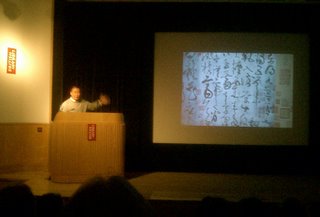 The British Library is just round the corner from work - it's so easy to drop in to an event, and at the moment there's an exhibition called "Beautiful Minds" about Nobel prize winners (which I haven't seen). In connection with this, they've got scientists etc doing talks, and this is Kathy Sykes, whose academic and popularising concern is making science accessible. Her (physics) PhD was on PHB, a biodegradable plastic obtained from the "fat" in bacteria. It raised a lot of ethical issues: "How can people trust scientists if they won't talk about ethics," she asked. Indeed. The discussion touched on creativity, explaining science to "naive" adults, researchers vs educationalists in academia, and politicians.
The British Library is just round the corner from work - it's so easy to drop in to an event, and at the moment there's an exhibition called "Beautiful Minds" about Nobel prize winners (which I haven't seen). In connection with this, they've got scientists etc doing talks, and this is Kathy Sykes, whose academic and popularising concern is making science accessible. Her (physics) PhD was on PHB, a biodegradable plastic obtained from the "fat" in bacteria. It raised a lot of ethical issues: "How can people trust scientists if they won't talk about ethics," she asked. Indeed. The discussion touched on creativity, explaining science to "naive" adults, researchers vs educationalists in academia, and politicians.Her first impression of science? Her father was a physicist; her mother knew about atoms, and that's how it started, a question to her mother and an explanation that aroused her curiosity.










 This example is later, expressive of the character of the writer. Possibly this was the one who changed sides to preserve his life, and rose to a high position under the new emperor.
This example is later, expressive of the character of the writer. Possibly this was the one who changed sides to preserve his life, and rose to a high position under the new emperor.

 Taking Leave of a Friend - by Li Bai
Taking Leave of a Friend - by Li Bai 

 So rather than put a nice neat narrow ribbon round my "baseball" to finish it off, I'm going to recycle bits of it as greeting cards -- some day.
So rather than put a nice neat narrow ribbon round my "baseball" to finish it off, I'm going to recycle bits of it as greeting cards -- some day.